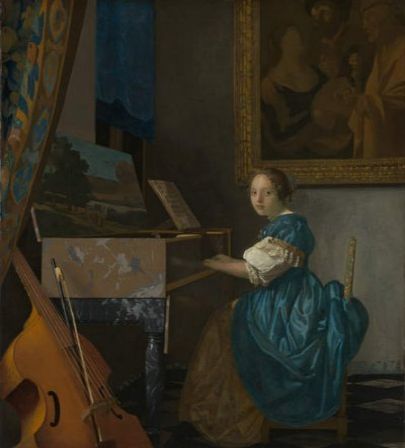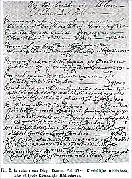Duarte's Vermeer

Johannes Vermeer
c. 1670–1675
Oil on canvas, 51.5 x 45.5 cm.
National Gallery, London

Koninklijke Bibliotheek, Brussel
Eyewitnesses of the Diego Duarte Collection
by Rudolf Rasch:
Diego (Duarte) had other artistic interests besides music. He was, perhaps following the footsteps of his father, a fervent collector of paintings.His collection is mentioned several times in the report of travelers who passed Antwerp, such as Balthasar de Monconys (1663), Constantijn Huygens Jr. (1676–1678), and the Swedish architect Nicodemus Tassin (1687). The visitors invariantly praise the collection's richness in Italian paintings of the sixteenth and seventeenth century (by Raphael, Titian, Tintoretto, etc.) and Flemish paintings of the seventeenth century (especially Rubens and Van Dyck). In 1682, Diego Duarte himself made a catalogue of his collection; the inventory not only gives clear insight in the making of the collection, but also gives the prices for which he bought the paintings and, in a number of cases, even their provenance.
: "The Antwerp Duarte Family as Musical Patrons" in Orlandus Lassus and his Time, Colloquium Proceedings Antwerpen 24.-26.08.1994. Alamire Foundation 1995, 424–425.
The Diego Duarte Inventory
by Edgar R. Samuel:
In 1683, Diego Duarte had prepared an inventory of his stock of some two hundred paintings together with the names of the artists and their cost prices. This inventory is now in the Royal Library in Brussels.For the manuscript reference: - Brussels MS II 94, Koninklijke Bibliotheek. It was published by Frederick Muller in 1870For the article by Frederick Muller: - Muller, Frederick. "Catalogus der schilderijen van Diego Duarte, te Amsterdam in 1682, met de prijzen van aankoop en taxatie." In De Oude Tijd (Haarlem), 1870, 397-402. and a revised version by Mr. G. Dogaer was republished in the 1971 Jaarboek3.For the first reference to G. Dogaer's work: - Dogaer, G. "De Inventaris der schilderijen van Diego Duarte." Jaarboek van het Koninklijk Museum voor Schone Kunsten Antwerpen, 1971, 195–221.
Before he died (1691), Diego Duarte appointed as his executor and principal heir, the only surviving competent male member of the family, Manuel Levy Duarte of Amsterdam.
At the time of the 1683 inventory the cost price of Diego Duarte's stock of paintings had been over 38,000 Fl. At the time of his death eight years later the collection was smaller by perhaps a third but its value was still substantial. The executors' problem was to realize the collection for the benefit of the estate as quickly as possible and it was difficult to do so.
Early in 1693 Manuel Levy listed the best of the unsold paintings remaining in Diego Duarte's house, together with their recommended retail prices. His descriptions are far less informative than those in the 1683 inventory, which he obviously had to hand, but sometimes they add information. (Diego's) inventory shows him to have been a meticulous and expert dealer. There is something very modern about Diego Duarte's approach to his task. He was prepared to lock up his capital for many years and stood out for good prices and a high profit margin.
It is clear from the two inventories and the records of sales that the seventeenth century art market was a sophisticated one and that success went to the skilful and learned dealer who built up a reputation for reliability and expertise.
Vermeer
by Albert Blankert (with contributions by Rob Rurrs and Willem vane Watering),, Oxford. 1978
Diego Duarte was an immensely wealthy Antwerp jeweler and banker. "It is suggestive that Duarte maintained contact with Holland through Constantijn Huygens the Younger, who, like Larson, lived in The Hague. Duarte's father had a clavecin made for Huygens, and Duarte corresponded with Huygens about music. He also was an accomplished organist and composer. With the musical interests it is appropriate that Duarte's Vermeer represented in his inventory number 182 "a small painting with a lady playing the clavecin, with accessories."
Vermeer and His Milieu: A Web of Social History
by John Michael Montias, Princeton, NJ: Princeton, 1989
The picture was valued at 150 guilders. This may have been either the Lady Standing at a Virginal or the Lady Seated at a Virginal both in the National Gallery of London although most Vermeer scholars tend to believe that the painting in question is the latter. Whichever it was, the other was in the Van Ruijven-Dissius collection.
L'inventaire des tableaux de Diego Duarte
excerpt from the ResuméFor the second reference to G. Dogaer's work, which seems to be the same as the first but with a specific page: - Dogaer, G. "De Inventaris der schilderijen van Diego Duarte." Jaarboek van het Koninklijk Museum voor Schone Kunsten Antwerpen, 1971, 195–221.
Les collectionneurs de tableaux ont été particulièrement nombreux à Anvers au XVIIe siècle. ... Une des plus importantes [galeries d'art] est certainement celle de Diego Duarte…Elle nous est connue par le récit de deux témoins oculaires, notamment celui de Constantin Huygens le Jeune, secrétaire de la maison d'Orange [1676], et celui de l'architecte suédois Nicodème Tessin [1687].
Comme l'édition de cet inventaire par F. Muller (dans un receuil presqu' introuvable) est souvent incorrecte, nous sommes proposé d'en fournir une réédition. Ce document, qui énumère environ 200 tableaux avec leur attribution et leur évaluation, permet de donner une idée du goût artistique de Duarte. La collection contenait en majeure partie des peintures de maîtres flamands et italiens. Les artistes contemporains y étaient surtout bien représentés.
(Collectors of paintings are particularly numerous in Antwerp in the seventeenth century...One of the most important [art galleries] is certainly that one of Diego Duarte. ...We know about it through the report of two eyewitnesses, above all from Constantijn Huygens Junior, secretary of the house of Orange [1676], and from the Swedish architect Nicodemus Tessin [1687].
As the edition of this inventory made by F. Muller (in a volume hardly anywhere to be found) is inaccurate in the most cases it has been proposed to furnish a re-edition. The document which enumerates c. two hundred paintings with their attributions and evaluations, gives us an idea of Duarte's artistic taste. The collection contains for the most part paintings of Flemish and Italian masters. The contemporary artists are particularly well represented.)
Johannes Vermeer in the Diego Duarte inventory
by Edwin Buijsen:
Some of the paintings will have appealed to Diego Duarte because of their musical nature…And in the case of number 182 on the inventory list, Lady Playing the Clavesingel [virginal] by Vermeer, its musical nature would almost certainly have played a role in its purchase. Certainly, Vermeer's "music piece" was utterly at home in the "maison musicale" of the Duartes.
: "Music in the Age of Vermeer," in M. C. van der Sman (ed.), Dutch Society in the Age of Vermeer, Zwolle 1996, 118.
The revised version of the inventory
by G. Dogaer, 1971
The entry no. 182 to the painting by Vermeer in the revised version of the Duarte inventory by G. Dogaer reads:5
182. Een stuckxken met een jouffrou op de clavesingel spelende met bywerck van
Vermeer kost guld. 150 (Muller, nr. 177)[A piece with a young woman playing the clavecimbel with accessoires by Vermeer cost]
:
Edgar R. Samuel, "The Disposal of Diego Duarte's Stock of Paintings 1692–1697," in Jaarboek van Het Koninklijk Museum voor Schone Kunsten Antwerpen, 1976, 305–309.
Diego Duarte or Jacob Duarte (1612–1691) was a seventeenth-century well-to-do Portuguese-Sephardic family who worked as a jeweler, banker, composer, organist and art collector living in Antwerp. He owned paintings by Vermeer, Raphael and others.
Duarte was born in Antwerp, the son of Gaspar Duarte I, a Christian diamond and art dealer who was befriended with e.g. Constantijn Huygens. Gaspar was the son of Diego Duarte I, and was born in 1584 in Antwerp. He later became the consul of Portugal in Antwerp. In 1635, Diego was appointed "jeweller in ordinary" by Charles I of England, but he returned to Antwerp in 1642. He received a part of the art collection of his father on his death in 1653, and continued collecting throughout his life. Part of his collection was sold in Amsterdam in 1682. Diego had a long correspondence and friendship with Constantijn Huygens, Jr. The house of the Duarte's in Antwerp was called the Antwerp Parnassus, a meeting place for intellectuals to enjoy art and music. Among Diego's sisters, Francisca, nicknamed Antwerp Nightingale (Rossignol Anversois) was the one frequently mentioned in the correspondence of both Constantijn and Christiaan Huygens. From Constantine's letters from the 1630s we learn that she sang duets with Maria Tesselschade Roemers Visscher (Tesseltjen), accompanied by Dirk Janszoon Sweelinck, son of the Amsterdam composer and organist Jan Pieterszoon, in the harpsichord. The beauty of this special vocal combination led Huygens' brother-in-law to close an epigram in their honor, Ad Tesselam and Duartam cantu nobiles. William III of England repeatedly stayed at the Duarte's house between 1674 and 1678. Diego's brother Gaspar Duarte II was an art collector as well, and his sister Leonora was a composer. After the childless death of Diego Duarte in 1691, no Duartes remained in Antwerp.
Some 200 paintings of Diego's collection were inherited by his nephew Manuel Levy Duarte. Most were sold between 1693 and 1696.
from Wikipedia: Diego Duarte